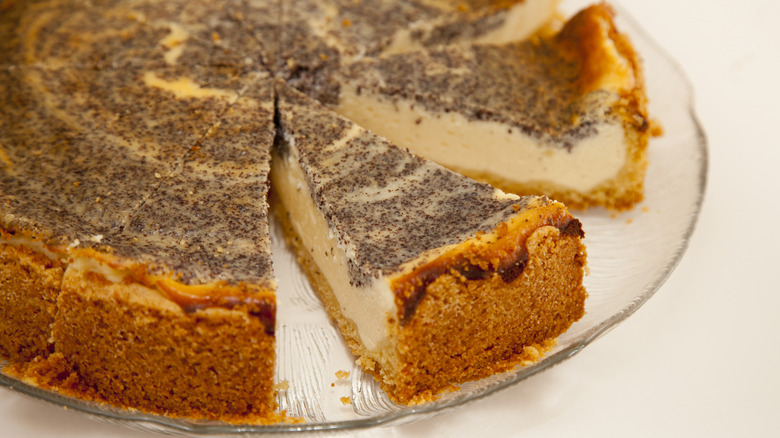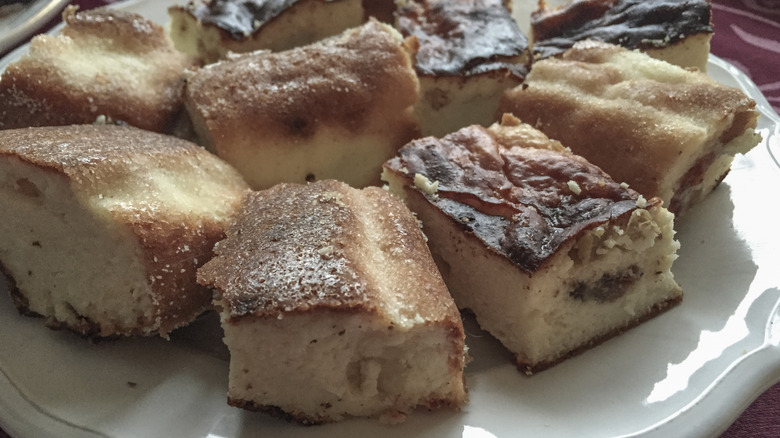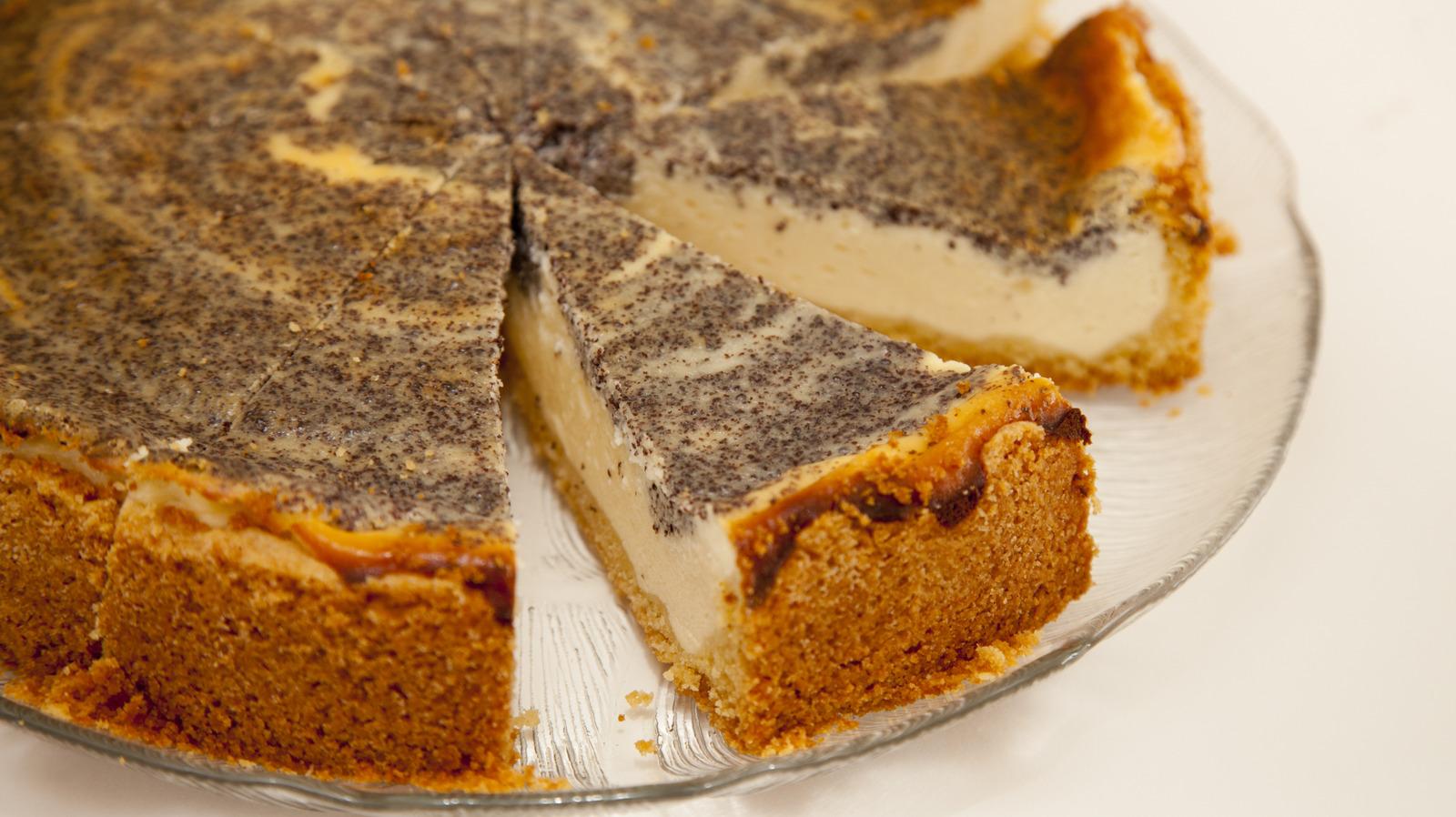
TunedIn by Westend61/Shutterstock
We may receive a commission on purchases made from links.
The mere mention of cheesecake tends to stir up a little saccharine excitement within most of us. But, did you know that its origins are actually ancient? The cheesecakes of today take on multiple forms: New York-style, Basque, and Japanese, but the concept of cheesecake has been around since the days of ancient Greece. It's remarkable that cheesecake has managed to stay relevant for all these centuries, yet that doesn't mean some styles and flavors of cheesecake from ages ago are still in high demand today.
A classic, New York-style cheesecake will always be a thing of beauty, just as a Basque cheesecake with its browned outer crust retains an air of regional refinement. Conversely, some types of cheesecake just aren't as popular as they used to be. When we do encounter the cheesecakes of the past, they are usually prepared with techniques and ingredients that feel more in step with contemporary tastes — Japanese cheesecakes often utilize this tactic, as do bakeries specializing in vintage desserts.
The old-fashioned cheesecakes that have faded into the recesses of history have close ties to the time periods from which they came. Certain cheesecakes aren't eaten much anymore because they were made with primitive cooking methods that have since been simplified, or local ingredients that aren't easy to come by for the average internet recipe follower. Take a look at the vintage cheesecakes that don't make it to the table much anymore, some of them might bring back some memories.
1. Plakous
It turns out that making food for Olympic athletes is a tradition that goes all the way back to ancient Greek civilization. The Greeks created the Olympic Games — and gave cheesecake an early platform in the process. This B.C.-era cheesecake, known as Plakous, looked quite different from the cheesecakes we now know and love. Long-term, Plakous hasn't held the public's attention nearly as well as the Olympics, but way back in the day, this cornerstone version of cheesecake was part of the Olympian diet.
The Greek island of Samos in the Aegean Sea has been credited as the birthplace of Plakous. It was made by mixing cheese, honey, and wheat flour in a pan until it was smooth. The pan would then be placed over hot embers to bake the mixture. The term "Plakous" in Greek refers to a flat cake and is commonly associated with this ancient baked cheesecake sweetened with honey. When the Olympic Games began around 776 B.C., Plakous became a source of sustenance for the competing athletes. The soft, loaf-like cake was also eaten at festive occasions or made as an offering to the gods.
Ancient Greece wasn't a cattle-raising land, so traditional Plakous incorporated sheep's or goat's milk. Cheesecake sweetened with honey is mentioned in "Deipnosophistae", an A.D. 200 anthology by Athenaeus documenting the societal practices of the ancient elite. Over time, as Roman conquerors moved in on Grecian land, the recipe for Plakous evolved. Eventually, the version enjoyed by the original Olympians faded away.
2. Savillum
The Roman Empire, established several hundred years after Ancient Greece, was influenced by the elder civilization's contributions to architecture, technology, philosophy, law making ... and the art of the cheesecake. One Roman interpretation of Plakous cheesecake from Greece was known as Savillum. Like its predecessor, Savillum hasn't been popular for quite a while.
Savillum was one of multiple cheesecakes the Romans developed and is the most similar to modern cheesecake. Roman placenta cake was a derivative of Plakous, with "placenta" translating in Latin to "flat cake." Similarly, libum was a cheese and flour loaf cake with a bready texture. Recipes for Savillum and libum were documented in "De Agri Cultura," a Roman farming manual written in 160 B.C. by Cato the Elder. Savillum stood out for its use of egg and a sprinkle of poppy seeds over the top. It was baked over a fire in a lidded terracotta pot.
Romans cut cooled Savillum into cubes so they could eat it with their hands. As the Roman Empire expanded its territory, Savillum also experienced geographical prominence. Regional versions of Savillum were made in the Middle East, Northern Africa, and across Europe. Although Savillum's far-reaching popularity eventually dwindled, it's fair to say that this throwback treat walked so that cheesecake could sprint all over the globe. Cato the Elder's Savillum recipe gets revived every once in a while, but you aren't likely to encounter it outside of a historical context.
3. Sambocade
By the 14th century, cheesecake had been around for a while. When a cheesecake called Sambocade emerged in England around 1390, it became clear that the Brits had given the dessert a royal treatment. A recipe for Sambocade, made from sugar, egg whites, cheese curds, and elderflower, appeared in "Forme of Cury," a medieval manuscript penned by the chefs of King Richard II. "Forme of Cury" is largely thought of as the oldest surviving cookbook in England, yet its creations, like Sambocade, aren't well-known anymore.
A traditional Sambocade calls for cheese curds to be strained and hand-blended into a paste, then mixed with an 8-2 ratio of egg yolks to egg whites. Sugar, cloves, and elderflower are added before baking (later versions also include rosewater). Sambocade differed from the cheesecakes that preceded it. Earlier cheesecakes were made from goat or sheep's cheese, while Sambocade used cheese curds from cow's milk. Incorporating sugar rather than honey was also a step toward modernization. Sugar was an expensive ingredient that most people in medieval England couldn't afford — then again, Sambocade was a cheesecake fit for a king.
The name Sambocade comes from "Sambucus", the Latin word for "elder." Centuries ago, elder trees, which are still plentiful in the U.K., were a folkloric symbol that represented protection from evil. Elderflowers have a delicate flavor, but it's one that is seen less in cheesecake and more often in mixology, usually by way of St-Germain elderflower liqueur.
4. Sour cream cheesecake
To make a New York or Chicago-style cheesecake, sour cream is often mixed into the cream cheese batter for flavor and texture. Yet sour cream's role in classic American cheesecakes was more pronounced in the early to mid 20th century. The once-common practice of adding a sour cream topping to cheesecake is fading into a decidedly old-school realm. With all of the cheesecake flavors available now, a simple, sour cream cheesecake tends to get lost in the shuffle.
New York-style cheesecake, easily one of the best-known cheesecakes in existence, was one of the first types of cheesecake to bring sour cream into the fold. Sour cream's tanginess helps balance out the sweetness of cheesecake, while its creamy consistency helps lighten up the density that comes with putting large amounts of cream cheese into a pie tin. Sour cream cheesecake topping also requires a balance of flavors. The sour cream gets mixed with sugar and vanilla extract before being spread atop the cheesecake. The topping also helps keep the cheesecake from cracking — or at least covers up any cracks that do form.
Not all vintage New York-style cheesecakes look to sour cream for textural perfection. Brooklyn-based Junior's, a beloved NYC institution since 1950, uses a mixture of cream cheese and heavy cream to achieve its flavor. And while Chicago-style cheesecake, like the one made famous by Eli's The Place for Steak in the 1970s, the signature recipe doesn't include sour cream topping.
5. Zapekanka

Berna Namoglu/Shutterstock
Cheesecake around the world takes on different forms depending on where it comes from. In many Eastern European nations, a casserole-like cheesecake called Zapekanka, or Tvoroznaya Zapekanka, is a classic food that has been baked for generations. For those who grew up eating Zapekanka, it's a taste of home (or school, where a lot of Soviet-era kids remember eating it). Yet cheesecake fans without ties to the cuisines of Eastern Europe probably haven't heard of or tasted Zapekanka, which may be why its notoriety isn't more widespread.
Zapekanka gets its fluffy texture from cottage cheese, or farmer cheese — a pressed fresh cheese used in Eastern European staples like sirniki (Ukrainian cheese pancakes) and pierogies (Polish dumplings). The cheese is combined with eggs, semolina or flour, butter, milk, and sugar. Raisins are the traditional mix-in, however, adding berries or savory ingredients is also done. Zapekanka bakes in a casserole dish for about 30 minutes — a breeze compared to the hour-plus bake times and pesky water baths other types of cheesecake require. Another difference between Zapekanka and other cheesecakes is that Zapekanka is eaten at breakfast.
Yes, Zapekanka normalized cheesecake at breakfast time. It's cut into pieces and sometimes topped with syrup, powdered sugar, and berries. Zapekanka can be served hot or cold, and with the help of bakers eager to preserve a little slice of culinary history, it will hopefully be served (at any temperature) for years to come.
6. Smoked salmon cheesecake
Savory cheesecakes don't command the limelight like their sweet counterparts, and while they are still made nowadays, certain flavors and preparation methods haven't had a lasting effect. Recipes for smoked salmon cheesecake began circulating in the mid 20th century, a time when hors d'oeuvres were charmingly overworked and best consumed with a martini nearby. These recipes, which involve baking smoked salmon within the pie, aren't seen much at cocktail parties anymore, or anywhere else for that matter.
The smoked salmon cheesecakes of yesteryear usually contained more than one type of cheese or dairy element. Cream cheese was pretty much a given, with additions ranging from Parmesan and Gruyère to crème fraîche. Regardless of variations, smoked salmon cheesecake is pretty labor intensive. Blind baking the crust, the dreaded water bath, long bake times, and even longer set times are a few of the potential obstacles that you may encounter depending on which smoked salmon cheesecake recipe you use.
If you encounter a smoked salmon cheesecake today, chances are it will look more like an open-faced salmon and lox situation. No-bake, or icebox cheesecakes remain popular, so turning one savory with slices of smoked salmon, fresh dill, a dollop of caviar, or capers is a logical move — and this too gives a nod to the past. Cream cheese and lox sandwich cakes called smörgåstårta were popular in Sweden around the same time smoked salmon cheesecakes were being baked in the U.S.
7. Zwieback crust cheesecake
When it comes to making cheesecake, the crust can be a game changer. Cheesecake crust is commonly made from a cookie-like crust, but like cheesecake itself, the crust has a wide berth for creative interpretation. In the mid-20th century, one cheesecake that made a name for itself was Zwieback crust cheesecake. Zwieback falls somewhere between a cracker, cookie, and pre-packaged toast. They were commonly given to teething babies to cut their teeth on, and they also happened to make a great cheesecake crust. Unfortunately, when Zwieback became harder to find in the U.S., this type of cheesecake became elusive as well.
The term "Zwieback" translates from German as "twice baked," and the ones most Americans bought were made by Nabisco. In the 1920s, when New York-style cheesecake was in its formative years, perfecting the crust was a trial and error endeavor. When the obvious choice of pastry crust was nixed in favor of pulverized crumbs, Zwieback toasts were among the first to get crushed. Even after graham crackers became a standard cheesecake crust ingredient, Zwieback crust cheesecakes endured.
Subtly sweet Zwieback toasts were crumbly and strong in color, making them a choice ingredient in double crust cheesecakes that had a moment in the mid-century. Double crust cheesecakes are characterized by coating the top of the cheesecake in a dusting of pulverized crust. Nabisco discontinued Zwieback toasts in 2011, presenting a major obstacle for admirers of this vintage cheesecake. To recreate the recipe, consider using Brandt Zwieback toasts instead.
8. Smierkase
A humble cheesecake out of Baltimore. Maryland called Smierkase is not a dish that too many people know. Smierkase takes the simplest of cheesecake ingredients: flour, sugar, butter, cottage cheese, sour cream, and egg. This light, mildly sweet cheesecake was popular amongst German immigrants who settled in Baltimore, and the name Smierkase, or Schmierkäse, is German for "cottage cheese." Local bakeries in the city sold Smierkase as early as 1927, but today, most of those businesses have closed.
Smierkase consisted of a yeasted crust beneath a moist yet fluffy cream cheese custard. The cake was typically baked in rectangular pans and finished with a signature sprinkling of cinnamon. Compared to cream cheese-centric American cheesecakes, Smierkase is breadier and more understated in flavor. It's the kind of cake that looks old-fashioned, mostly due to its "take me as I am" topping of powdered cinnamon and a soft texture that seems like a benchmark in cheesecake's ongoing evolution. If Smierkase's modest existence has piqued your palate, head to Baltimore. Finding it anywhere else seems like an exercise in futility.
9. Buttermilk cheesecake
At its purest, cheesecake is a tart food. Those who aren't in love with cheesecake's tangy notes opt to douse in chocolate, syrupy fruit, or another sugary concoction. We totally get that, yet for some cheesecake enthusiasts, those tangy notes are what makes this dessert stand out from other treats. That hint of sharpness, or fermentation, can be achieved by adding buttermilk to cheesecake. Buttermilk cheesecake is a vintage-y version of the dessert, and its following is rather limited in this day and age.
Buttermilk cheesecake is an offshoot of buttermilk pie, a time-honored Southern dish that regional pockets of the U.S. still embrace. Buttermilk pie's origins have been traced back to England. It was favored for its pantry staple ingredients — butter, flour, eggs, sugar, and buttermilk — a tart, cloudy liquid left behind while turning cream into butter. When British colonists settled in the American South, buttermilk pie came along. Both cheesecake and buttermilk pie are traditionally served during holiday celebrations — another reason why combining the two desserts made sense.
Despite buttermilk's association with old-school American baking, the inclusion of buttermilk (now sold as a commercially made mixture of milk and lactic acid) in cheesecake doesn't only apply to the cream cheese-based cheesecakes that are so ubiquitous in the U.S. Buttermilk is also a welcome addition in ricotta cheesecake, a traditional style of the dessert that is perpetually popular in Italy.
10. Sweet potato cheesecake
Cheesecake toes the line between cake, custard, and pie which is why it takes so kindly to many different flavors. Cheesecake's mercurial nature allows it to meld with other throwback pie flavors in seamless fashion. Sweet potato cheesecake is a successful mashup, albeit one that isn't flying off the shelves as of late.
Sweet potato pie has deep, significant roots in Southern cuisine, specifically within soul food. The sweet potato's similar texture and appearance to tropical yams is likely what drew African Americans living in the South to transform these tubers into dessert. In West Africa — the land many enslaved people called home — yams were eaten in breadlike sweets. As cheesecake's popularity mounted in the late 19th century and beyond, it was only a matter of time before elements from both desserts were combined into a hybrid treat.
Sweet potato cheesecakes often feature a graham cracker or cookie crust and are spiced with plenty of cinnamon and nutmeg. A baked nut topping, streusel-like crumble, or whipped cream are popular finishes for sweet potato cheesecake, which tends to be relegated to festive occasions where home cooking prevails. Commercially, specialty bakeries are keeping sweet potato cheesecake from fading away completely. Fluffy Japanese cheesecakes featuring purple Okinawan sweet potatoes or Southeast Asian ube are sold at Asian bakeries. Classic sweet potato cheesecake can be found at bakeries showcasing Southern-style pies.
11. Woolworth's cheesecake
For much of the 20th century, Woolworth's was an American institution. It was a five-and-dime, a luncheonette, and even a pet store — if goldfish, hamsters, parakeets, or tiny turtles were your style. Woolworth's lunch counter was a big selling point for the retailer, and having a signature food item was a great way to stay memorable. That's exactly what Woolworth's did when it introduced its eponymous lemon cheesecake. In its quest to launch a standout cheesecake, Woolworth's popularized a style of the dessert that would live on even after Woolworth's 1997 demise.
Woolworth's cheesecake was an early commercial offering of no-bake, or icebox cheesecake. Copycat recipes abound, but according to those who tasted the real thing, a graham cracker crust, cream cheese, evaporated milk, lemon Jell-O flavoring, and a sprinkling of graham cracker crumble on the top of each slice were hallmarks of the original recipe. The icebox cheesecake sold at Woolworth's lunch counters were shilled in a rectangular baking dish and served in squared-off slices — yet another way to differentiate its recipe from the triangle-cut cheesecake slices of the world.
Woolworth's lemony icebox cheesecake has since faded from relevance. Woolworth's doesn't take credit for inventing the no-bake cheesecake, but it was an early adapter of the burgeoning cheesecake style.



